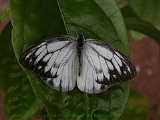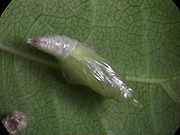
Cepora nerissa
Encyclopedia
The Common Gull is a small to medium-sized butterfly
of the Family Pieridae
, that is, the Yellows and Whites, which is native to India
.
-_male_in_narshapur,_ap_w_img_0827.jpg) ile:Huphina nerissa.jpg|thumb|Female- Woodcut from C.T.Bingham, The Fauna of British India, Including Ceylon and Burma,
ile:Huphina nerissa.jpg|thumb|Female- Woodcut from C.T.Bingham, The Fauna of British India, Including Ceylon and Burma,
Male upperside: white, a greyish-blue shade at base of wings and along the veins, due to the dark markings on the underside that show through. Fore wing: veins black; apex and termen black, the inner margin of that colour extended in an irregular curve from middle of costa to base of terminal third of vein 4, thence continued obliquely outwards to the tornal angle; interspaces 6 and 9 with short narrow greyish-white streaks of the ground-colour that stretch into the black apical area but do not reach the margin; a short black subterminal bar between veins 3 and 4 and another, less clearly defined, between veins 1 and 2. Hind wing: veins 4 to 7 with outwardly-dilated broad black edgings that coalesce sometimes and form an anterior, irregular, black, terminal margin to the wing. Underside, fore wing: white, the veins broadly margined on both sides by dusky black; costal margin broadly and apex suffused with yellow; subterminal black bars between veins 1 and 2, and 3 and 4 as on the upperside but less clearly defined. Hind wing entirely suffused with yellow, the veins diffusely bordered with black; a more or less incomplete, subterminal series of dusky spots in interspaces 1 to 6; more often than not the spot in 5 entirely absent; a conspicuous chrome-yellow spot on the precostal area. Antennae black, obscurely speckled with white; head and thorax bluish grey; abdomen dusky black; beneath: the palpi and abdomen white, the thorax yellow.
Female similar to the male but very much darker. Upperside: veins more broadly bordered with black; in many specimens only the following portions of the white ground-colour are apparent:—Fore wing: a broad streak in cell and beyond it a discal series of streaks in interspaces 1 to 6, 9 and 10; the streaks in interspaces 1 and 3 very broadly interrupted by the transverse black bars ; that in 6 more or less obsolescent. Hind wing: a broad streak in cell, a discal series of streaks in interspaces 2 to 7, and a posterior more or less obsolescent subterminal series of greyish-white double spots. Underside similar to that of the male only the veins much more broadly margined with diffuse black scaling. Antennae, head, thorax and abdomen as in the male.
_is_it_at_jayanti,_duars,_wb_w_img_5555.jpg)
-_male_at_hodal_iws_img_1136.jpg) Differ From the wet-season brood as follows:— Male upperside, fore wing: the apical and terminal black areas much restricted; veins concolorous; black subterminal bare less clearly defined; the lower one often obsolete. Hind wing: the black markings on tho termen represented by short triangular irrorations of black scales at the apices chiefly of the anterior veins. Underside: as in the wet-season specimens, but the yellow much paler and somewhat ochraceous in tint.
Differ From the wet-season brood as follows:— Male upperside, fore wing: the apical and terminal black areas much restricted; veins concolorous; black subterminal bare less clearly defined; the lower one often obsolete. Hind wing: the black markings on tho termen represented by short triangular irrorations of black scales at the apices chiefly of the anterior veins. Underside: as in the wet-season specimens, but the yellow much paler and somewhat ochraceous in tint.
Female differs less from the wet-season female, but the black markings on both the upper and under side are narrower and less pronounced, and on the latter the yellow suffusion is paler and ochraceous in tint.
 " Greenish; thorax and basal abdominal segment acutely angled." (de Niceville MS)
" Greenish; thorax and basal abdominal segment acutely angled." (de Niceville MS)
Cepora lichenosa is treated as a full species by some authors.
Category:Pierini
Category:Butterflies of India
fr:Cepora nerissa
ml:നാട്ടുപാത്ത
nl:Cepora nerissa
vi:Cepora nerissa
Butterfly
A butterfly is a mainly day-flying insect of the order Lepidoptera, which includes the butterflies and moths. Like other holometabolous insects, the butterfly's life cycle consists of four parts: egg, larva, pupa and adult. Most species are diurnal. Butterflies have large, often brightly coloured...
of the Family Pieridae
Pieridae
The Pieridae are a large family of butterflies with about 76 genera containing approximately 1,100 species, mostly from tropical Africa and Asia. Most pierid butterflies are white, yellow or orange in coloration, often with black spots...
, that is, the Yellows and Whites, which is native to India
India
India , officially the Republic of India , is a country in South Asia. It is the seventh-largest country by geographical area, the second-most populous country with over 1.2 billion people, and the most populous democracy in the world...
.
Wet-season brood
-_male_in_narshapur,_ap_w_img_0827.jpg)
Male upperside: white, a greyish-blue shade at base of wings and along the veins, due to the dark markings on the underside that show through. Fore wing: veins black; apex and termen black, the inner margin of that colour extended in an irregular curve from middle of costa to base of terminal third of vein 4, thence continued obliquely outwards to the tornal angle; interspaces 6 and 9 with short narrow greyish-white streaks of the ground-colour that stretch into the black apical area but do not reach the margin; a short black subterminal bar between veins 3 and 4 and another, less clearly defined, between veins 1 and 2. Hind wing: veins 4 to 7 with outwardly-dilated broad black edgings that coalesce sometimes and form an anterior, irregular, black, terminal margin to the wing. Underside, fore wing: white, the veins broadly margined on both sides by dusky black; costal margin broadly and apex suffused with yellow; subterminal black bars between veins 1 and 2, and 3 and 4 as on the upperside but less clearly defined. Hind wing entirely suffused with yellow, the veins diffusely bordered with black; a more or less incomplete, subterminal series of dusky spots in interspaces 1 to 6; more often than not the spot in 5 entirely absent; a conspicuous chrome-yellow spot on the precostal area. Antennae black, obscurely speckled with white; head and thorax bluish grey; abdomen dusky black; beneath: the palpi and abdomen white, the thorax yellow.
Female similar to the male but very much darker. Upperside: veins more broadly bordered with black; in many specimens only the following portions of the white ground-colour are apparent:—Fore wing: a broad streak in cell and beyond it a discal series of streaks in interspaces 1 to 6, 9 and 10; the streaks in interspaces 1 and 3 very broadly interrupted by the transverse black bars ; that in 6 more or less obsolescent. Hind wing: a broad streak in cell, a discal series of streaks in interspaces 2 to 7, and a posterior more or less obsolescent subterminal series of greyish-white double spots. Underside similar to that of the male only the veins much more broadly margined with diffuse black scaling. Antennae, head, thorax and abdomen as in the male.
Dry-season brood
_is_it_at_jayanti,_duars,_wb_w_img_5555.jpg)
-_male_at_hodal_iws_img_1136.jpg)
Female differs less from the wet-season female, but the black markings on both the upper and under side are narrower and less pronounced, and on the latter the yellow suffusion is paler and ochraceous in tint.
Distribution
The N.W. Himalayas up to 4000 ft.; Nepal; Sikkim; Bhutan; Bengal: Central, Western and Southern India; Ceylon.Larva
"Cylindrical, tapering at the anal end; finely white-dotted, with a lower lateral white line. Feeds on Capparis." (Thwaites) Seems to prefer only Capparis zeylanica in Pune.Pupa

Subspecies
- C. n. cibyra (Fruhstorfer, 1910) (Taiwan)
- C. n. coronis (Cramer, 1775) (China)
- C. n. corva (Wallace, 1867) (Java)
- C. n. dapha (Moore, 1879) (central Burma, eastern Burma to Thailand, nortern Peninsular Malaya, Langkawi)
- C. n. evagete (Cramer, 1775) (Sri Lanka, S.India)
- C. n. lichenosa (Moore, 1877) (Andamans)
- C. n. nerissa (Fabricius, 1775) (nortern Vietnam, southern China)
- C. n. phryne (Fabricius, 1775) (northern India to western Burma)
- C. n. physkon (Fruhstorfer, 1910) (Lombok)
- C. n. sumatrana (Hagen, 1894) (Sumatra)
- C. n. vaso (Doherty, 1891) (Sumbawa)
- C. n. yunnanensis (Mell, 1951) (Yunnan)
Cepora lichenosa is treated as a full species by some authors.
See also
Category:Pierini
Category:Butterflies of India
fr:Cepora nerissa
ml:നാട്ടുപാത്ത
nl:Cepora nerissa
vi:Cepora nerissa

